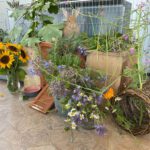Rabbits are by nature curious and active animals that need plenty of space to jump, explore, and hide. People who keep rabbits in an apartment or house often wonder whether a dedicated rabbit room is the right solution for their well-being. A rabbit room not only offers more space and freedom, but also an environment adapted to their natural needs, and it is suitable even for rabbits that are not very clean or tend to chew and destroy things.
Contents
- Which room is suitable?
- Access to the balcony or garden?
- Rabbit room with access to the garden
- Dual use: home office, fitness room, or others as a rabbit room?
- Hygienic and non-slip floor protection
- Wall protection
- Platforms and levels
- Safety in the rabbits’ room
- Toys and entertainment
- More tips:
- Cleaning and hygiene
- Litter training
- Air circulation and ventilation
- Important tips:
Which room is suitable?
Before preparing the room for your rabbits, it’s important to choose the right space. It should have at least six square meters to meet the minimum requirement, although the bigger, the better. Ideally, it should be a bright place, but not directly exposed to sunlight, since rabbits can easily suffer from heat. Attic rooms are not recommended, as they get too hot in summer; if there is no other option, an air-conditioning system may be necessary. Drafts should also be avoided, and the room should be quiet, away from loud noises or constant traffic. The best option is for the rabbits to have contact with the family through an open door, so they can observe daily life in the home and not get bored.
Rabbits should NEVER live alone and need space to jump and play. That’s why the room must provide enough area for them to express their natural behaviors. A minimum of 6 m² for two rabbits is ideal, although the larger the space, the better. Also keep the height of the room in mind: rabbits love to jump and climb.
Access to the balcony or garden?
If the rabbits are going to have access to the outdoors, the room should be chosen so that this is possible (see tips on how to secure and adapt the balcony).
Rabbits can have access to the balcony or garden all year round, even in snow or rain, as long as they can return at any time to a suitable and stable temperature.
Rabbit room with access to the garden
Having access to a safe outdoor space is a great advantage for rabbits. A protected area in the garden, where they can graze and run around, supports both their physical and mental health. There are different ways to connect the rabbits’ room with a garden or balcony, so the animals can play outside in complete safety.
How to Care for Outdoor Rabbits
Dual use: home office, fitness room, or others as a rabbit room?
Shelves can be used to create storage space in the rabbits’ room; if cables are well protected, it’s also possible to set up a home office there, and exercise equipment can share the same space without problems. In this way, dual use can help you save money and make better use of the living space.
Hygienic and non-slip floor protection
The type of flooring is a crucial factor. Rabbits have very sensitive paws and need a soft surface, but at the same time it should be practical and easy to clean. The best choice is a solid floor such as PVC or linoleum: it resists urine and can be cleaned without complications. A carpeted floor, on the other hand, is not suitable, as it absorbs dirt and moisture and is difficult to clean. To give rabbits good grip when jumping, washable rugs can be placed. It’s also possible to cover certain areas of the floor or large trays with bedding, straw, or hay, so the animals feel more comfortable. It is especially important to provide well-padded resting areas to prevent injuries or sores on their paws (pododermatitis).
Wall protection
If your rabbits tend to gnaw on the wall, it’s advisable to install a protective covering, for example a thin wooden panel (like those used for the backs of wardrobes) with a coating that makes it easy to clean, branches, or Songmics-style panels. It’s important to always leave a small gap between the protection and the wall to prevent mold.
What you need for your rabbits’ room
- Shelters and hiding places (e.g., wooden houses) where they can retreat.
- Protected areas from which they can observe what’s happening, such as under furniture.
- Tunnels to crawl through, which stimulate exploration and play.
- Elevated levels: organize the room at different heights with platforms and allow the rabbits access to the windowsill as well.
- Plenty of chewing material (branches, suitable toys, etc.).
- A digging box to satisfy their natural digging instinct (especially in unspayed females).
- Elevated observation points such as the windowsill, chairs, cat scratching posts, shelves, or flat house roofs, from which they can watch the room.
- A feeding area with a large tray underneath that also serves as a litter box, which can also be placed under larger pieces of furniture.
- Several large litter boxes with hay racks (one with hay and another with fresh greens) above them — ideally number of rabbits + 1, or at least one per room.
- A water bowl in an accessible spot, free of bedding.
- A UVB lamp to support vitamin D synthesis (see section on Vitamin D).
Rabbits love to explore their surroundings and hide in small caves or corners. A well-planned room layout helps them feel safe and comfortable. Place boxes or shelters where they can hide.
If the room needs to be accessible, or if your rabbits have special needs, here you will find tips on equipment adapted for older, sick, or disabled rabbits.
You can also choose a color scheme for the rabbits’ room (for example, wood tones, green, and white) and decorate it to your taste.
Platforms and levels
Think in three dimensions and make use of the room’s height! Rabbits love to sit up high, watch their surroundings, and jump onto elevated objects. That’s why platforms, the roofs of little houses, and raised seating spots are a great enrichment for any rabbit room.
Elevated resting places meet a basic need for security: as prey animals, rabbits can observe their environment from above and feel more protected.
In addition, different levels add variety and more opportunities for entertainment.
Note! Platforms can improve and enrich the enclosure, but they never replace the basic minimum floor area of 6 m².
Safety in the rabbits’ room
Since rabbits are naturally very curious, you need to make sure the room contains no potential hazards. Prevent them from accessing cables or other electrical devices. Toxic plants should be removed from the room, as well as sharp edges or loose parts that could cause injury. Regularly check that all furniture and objects are safe and pose no risk.
Toys and entertainment
In addition to having freedom of movement within the room, it’s important to provide rabbits with both physical and mental stimulation. Place some toys, such as paper rolls or wooden rabbit toys. Tunnels and platforms also encourage activity. Remember that rabbits need mental challenges: for example, you can hide treats in the hay or straw, or set up small obstacle courses to spark their curiosity.
More tips:
- Use natural materials (fresh and dried branches, leaves, stones, soil, sand, etc.).
- Play music or relaxing sounds (for example, nature sounds).
- Change the arrangement of objects in the room from time to time.
Cleaning and hygiene
A clean rabbit room is essential for the animals’ well-being. Clean the room regularly, especially the litter boxes. Rabbits are naturally very clean and need a hygienic environment. Remove hay and bedding frequently, change the water daily, and also clean the feeding areas. Good hygiene also helps prevent bad odors
Litter training
Rabbits are naturally very clean animals and usually learn to use a litter box easily. A large box with the right bedding is generally well accepted by most rabbits. It’s recommended to place several litter boxes in the corners of the room until they develop the habit of using them; in any case, there should always be one more box than the number of rabbits you have. Choose large litter boxes so that two rabbits can comfortably lie in them at the same time.
Air circulation and ventilation
Proper ventilation: in a well-ventilated room, air circulates constantly, which prevents the buildup of harmful gases such as ammonia (urine odor) and promotes air exchange. This not only prevents bad smells but also stops the spread of mold spores or bacteria that could endanger the animals’ health. Ventilation is especially important in winter, when windows often stay closed.
Opening windows: whenever possible, open a window regularly to renew the air in the room. Even in the colder months, this is advisable: short, intensive ventilation of 5 to 10 minutes is usually enough to refresh the air without lowering the temperature too much. Ideally, mosquito screens should be installed to protect rabbits from fly larvae. Make sure no drafts are created.
Air purifiers: in environments with high pollution levels, for example in urban areas, an air purifier can be useful to filter harmful substances and improve indoor air quality.
Risk of humidity and mold: poor ventilation or insufficient fresh air supply can quickly cause problems if moisture builds up in the room. This happens especially in winter, when heating raises humidity levels and airing is neglected. Under these conditions, mold can form, and its spores are very dangerous for rabbits, potentially causing serious respiratory diseases. To reduce the risk, the rabbits’ room should be ventilated frequently and checked for moisture buildup, especially in corners or behind furniture, where air stagnates and damp spots or mold may appear.
Important tips:
- At least 6 m² of space for two rabbits.
- A safe room with clean air.
- Soft, easy-to-clean flooring.
- Entertainment options and hiding places.
- Daily cleaning




















